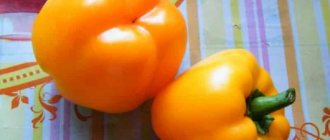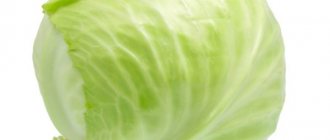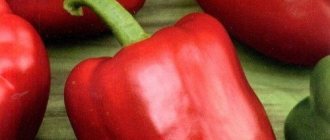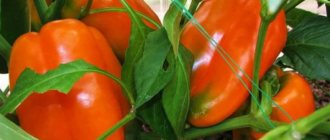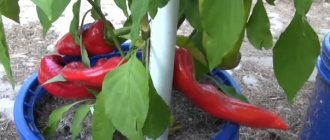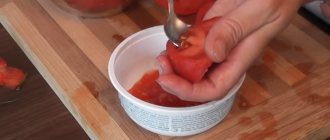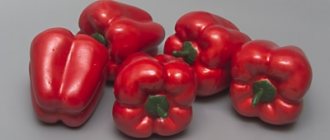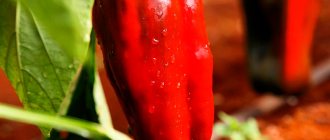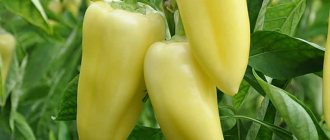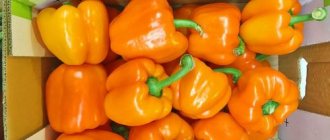Description
Pepper Lesya is an early ripening variety. Its bushes are low, up to 60 cm, but spreading. The leaves are smooth and the same size as the fruits. The stems are thick, but during the fruiting period they need support and tying.
The fruits are dark red, large, fleshy, juicy, up to 10 cm in length, weighing up to 160 g. Thickened walls up to 8-10 mm are visible on the cut. Particularly attractive is the unusual heart-shaped shape of peppers with an elongated, sometimes curved nose. The surface is smooth, shiny, there are no ribs. The seeds are located in 2 compartments separated by partitions.
Features of cultivation.
If you plan to plant in the ground from the tenth to the twentieth of May, then you need to sow the seeds for seedlings from the twenty-fifth of February to the fifth of March. If you plan to plant later, then sowing should be postponed for ten days. The most important thing is that the seedlings do not have time to bloom, otherwise after planting the peppers will shed their flowers and you will lose the first harvest, and accordingly the time for filling and ripening of the fruits will increase. Three or four plants are hatched per square meter. When planting, you can apply complex mineral fertilizer or a mixture of humus and ash.
Main characteristics
Pepper is perfectly stored and transported. In cool conditions it can last up to 5-7 weeks. It is convenient to transport: the fruits do not break or crack, and can withstand shaking.
Related article:
Sweet pepper Pinocchio
Plants need good soil. They are picky about the soil and do not produce enough fruit if there is a lack of nutrients. At the same time, the crop is drought-resistant and does not require abundant watering.
Important! 6 tips to increase your pepper harvest
Planting seedlings in greenhouses or open ground
When planting seedlings in a permanent growing place, the plants need to be removed from the pots very carefully, along with a lump of earth. The fact is that the small roots of peppers do not recover well, not at all like the roots of tomatoes
- It is recommended to add nitroammophoska and a little wood ash to the planting holes. Before planting, water the hole generously with warm water. Do not bury the plant below the cotyledon leaves in the soil.
- Some novice gardeners strive to plant seedlings as deep as possible. It is not right. The fact is that the formation of additional roots, which will come from a stem immersed in a layer of soil, will require significant time and resources. The plant will stop its growth and development. It will bloom a couple of weeks later and, accordingly, will bear fruit later.
- Don't try to plant seedlings too early. Wait for persistent warm weather. It is best to plant peppers in the ground in late May, or even early June. After planting for the first time, you can protect the plantings with film, non-woven material or fiber. The shelter will save tender seedlings from the bright rays of the sun and gusts of wind.
- The first feeding can be done when the seedlings take root, 2 weeks after planting.
- Pepper is very responsive to organic matter. Prepare herbal slurry for watering the bushes at the root. To prepare it, you can use any grass, garden weeds, dandelions and other plants. The herbal material is placed in a container, filled with water and kept for 3 weeks. After the fermentation process is completed, the infusion is filtered, diluted with warm water and the bell pepper is poured under the root, into the pits or furrows. It has been noticed that after such herbal fertilizers, the yield and quality of fruits improve.
- If you grow Lesya pepper in a greenhouse, keep in mind that at temperatures above 35 degrees and low air humidity, the pollen becomes sterile, pollination and fertilization stop, and fruits do not set. Therefore, take care of ventilation of greenhouses and arrange vents.
This crop can be re-grown in the same place no earlier than after three years. Good predecessors for peppers are onions, peas, and cabbage.
The fruits are collected at the stage of technical ripeness. Lesya pepper ripens in waves, fruiting lasts until mid-October.
Diseases and pests
The Lesya variety is a tasty morsel for insects. It is also susceptible to fungal diseases, so it requires careful care and regular spraying. The most common diseases are:
- late blight;
- black and gray rot;
- blackleg;
- Alternaria blight.
Related article:
Pepper in open ground: avoiding mistakes
Of the insects, the vegetable is often attacked by slugs, aphids, and mole crickets.
To combat the fungus, use such products as Fundazol (20 g per 1 liter of liquid), copper sulfate (3 sachets per 10 liters of water), Privent, Baktofit, Planriz preparations (diluted according to the instructions).
Spraying against insects is carried out with insecticides. The most effective of them are Akarin, Fitoverm, Zolon, Sunmite. The preparations are diluted according to the recommendations on the packaging and sprayed over the plants from a spray bottle. To obtain a stable result, several treatments per season are required.
Care
Proper care is the key to strong, healthy bushes and high yields . You need to start preparing for the season in February-March. At this time, prepare containers for planting and soak the seeds.
Before landing
| Actions | Algorithm and features |
| Preparation of seed material |
|
| Soil and containers for planting | For the Lesya variety, it is better to choose fertile soil - this is the basis for a good harvest. Soil substrate composition:
For every kilogram of the resulting mixture add 1 tbsp. wood ash. No other fertilizers are applied at this time. Next, it is necessary to disinfect the soil. This can be steaming, heating or pouring boiling water. Containers for planting seeds - plastic cups, containers or pots no larger than 0.5 liters. If the container is reused, it must be disinfected. |
| Sowing seeds in the ground in separate containers |
|
| Actions after sprouts appear |
|
The presented method is most often used for growing Lesya pepper in greenhouse conditions.
In open ground conditions, preliminary preparation of sprouts and seedlings is not necessary: the seeds are sown immediately in a permanent place, after warm weather has established itself (late April-early May). The seeds can be pre-germinated as described above.
It is forbidden to plant Lesya pepper next to bitter varieties of pepper. This threatens cross-pollination: sweet fruits will taste bitter.
After landing
Care consists of:
- regular watering;
- fertilizing;
- timely removal of weeds.
After watering, the soil needs to be loosened and mulched to allow moisture to evaporate more slowly. In hot weather, it is recommended to water the bushes 2 times a day: in the morning and evening hours.
It is necessary to carry out foliar feeding 2-4 times per season. For these purposes, you can take both store-bought preparations (Kemira) and folk remedies (succinic acid, chicken droppings, ash, boric acid). Spraying is prohibited during the day due to the risk of foliage burns.
Advantages and disadvantages
Lesya pepper has many advantages compared to other varieties:
- resistant to drought and tolerates it well;
- juicy, meaty, has excellent taste;
- suitable for any method of consumption;
- does not crack, is well stored and transported;
- grows both in greenhouses and in open ground;
- the culture produces high-quality seeds that can be used for planting, since it is a variety and not a hybrid;
- high yield.
Related article:
When to plant peppers in open ground
Among the disadvantages, we can mention the need to tie up bushes and regularly carry out treatment against pests and diseases.
Landing
Seeds should be prepared before planting.
| Procedures | Nuances of carrying out |
| Calibration | Seeds are poured into a 1% saline solution. The grains that have sunk to the bottom are selected for planting. Discard floating and damaged seeds |
| Soaking for germination | Fill with water at room temperature for a couple of hours |
| Activation | Soak for 5-6 hours in a stimulator (Agate, Immunocytophyte, Humisol, Humate) You can use natural activators (aloe, honey) |
The prepared seeds are transferred to a moistened cloth and covered with film. Maintain moisture by wetting. After 5-10 days, white dots will appear. Without waiting for the roots, the seeds are placed into holes or grooves with tweezers. The depth of the soil is 0.8-1 cm.
The soil used is fertile, neutral, based on turf substrate from a garden or park area. Optimal composition:
- turf - 1 part;
- rotted compost - 1 part;
- sand - 1 part;
- additives (vermicompost, phosphorus-potassium mixture).
To disinfect the soil, pour boiling water over it and keep it in the oven at 200 degrees for about half an hour. In the microwave, the procedure lasts 5-6 minutes. Potassium permanganate and boric acid have a good disinfecting effect. You should also treat containers for planting: boxes, pots, glasses. Copper preparations are used to wipe the walls of greenhouses.
